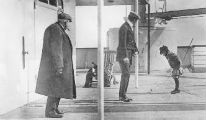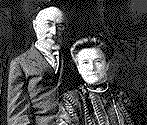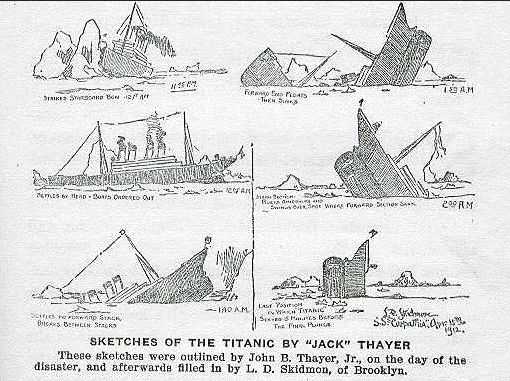Demographics of the
|
|
I hesitated before creating yet another Titanic Web site, but after I saw the movie Titanic [that tells you how long this page has been around], I was inspired to finish up some research I had started quite some time before. I was curious about the demographics of the passengers and crew of the Titanic -- who perished, who survived, and who occupied which lifeboats. How gravely was the tragedy enhanced by gender, class distinction, and prejudice?
On this site I have compiled numbers, comparing several different sources. The numbers make it all too clear that a rule of First Class First far outweighed the principle of Women and Children First. In addition to simply compiling numbers, however, I have included some notes and analysis and share the sources I used to compile the data.
 |
 |
Deaths and Survivals
|
|
|
Women |
Children |
Men |
Total |
|
Total Total: 412 |
Total Total: 112 |
Total Total: 776 |
Total Total: 1300 |
|
Total Total: 22 |
Total None. |
Total Total: 896 |
Total Total: 918 |
|
Total Total: 434 |
Total Total: 112 |
Total Total: 1680 |
Total Total: 2226 |

|
Breakdown of Passengers by Class |

|
|---|
|
Women |
Children |
Men |
Total |
|
First Class Total: 141 |
First Class Total: 7 |
First Class Total: 171 |
First Class Total: 319 |
|
Second Class Total: 92 |
Second Class Total: 25 |
Second Class Total: 155 |
Second Class Total: 272 |
|
Third Class (Steerage) Total: 179 |
Third Class (Steerage) Total: 80 |
Third Class (Steerage) Total: 450 |
Third Class (Steerage) Total: 709 |
|
Total Total: 412 |
Total Total: 112 |
Total Total: 776 |
Total Total: 1300 |
|
Third Class Died: 16 |
Third Class Died: 17 |
Third Class Died: 110 |
Third Class Died: 143 |
|
Third Class Died: 41 |
Third Class Died: 29 |
Third Class Died: 174 |
Third Class Died: 244 |
|
Third Class Died: 11 |
Third Class Died: 4 |
Third Class Died: 51 |
Third Class Died: 66 |
|
Third Class Died: 23 |
Third Class Died: 5 |
Third Class Died: 46 |
Third Class Died: 74 |
|
|
Breakdown of Passengers by Nationality |
|---|
| Nationality | FIRST CLASS | SECOND CLASS | THIRD CLASS | Total | ||||||||||||
| Total | Survived | Died | Percent Survived | Total | Survived | Died | Percent Survived | Total | Survived | Died | Percent Survived | Total | Survived | Died | Percent Survived | |
| American | 212 | 141 | 71 | 67% | 51 | 24 | 27 | 47% | 43 | 12 | 21 | 28% | 306 | 177 | 119 | 58% |
| Australian | 0 | 1 | 0 | 1 | 0% | 1 | 1 | 0 | 100% | 2 | 1 | 1 | 50% | |||
| Austro Hungarian | 1 | 0 | 1 | 0% | 4 | 1 | 3 | 25% | 44 | 7 | 37 | 16% | 49 | 8 | 41 | 16% |
| Belgian | 1 | 1 | 0 | 100% | 1 | 0 | 1 | 0% | 22 | 5 | 17 | 23% | 24 | 6 | 18 | 25% |
| British | 45 | 20 | 25 | 44% | 164 | 68 | 96 | 41% | 118 | 18 | 100 | 15% | 327 | 104 | 223 | 32% |
| Bulgarian | 0 | 0 | 33 | 0 | 33 | 0% | 33 | 0 | 33 | 0% | ||||||
| Canadian | 27 | 13 | 14 | 48% | 2 | 1 | 1 | 50% | 5 | 0 | 5 | 0% | 34 | 14 | 20 | 41% |
| Chinese | 0 | 0 | 8 | 6 | 2 | 75% | 8 | 6 | 2 | 75% | ||||||
| Danish | 0 | 3 | 0 | 3 | 0% | 7 | 1 | 6 | 14% | 10 | 1 | 9 | 10% | |||
| Dutch | 1 | 0 | 1 | 0% | 0 | 0 | 1 | 0 | 1 | 0% | ||||||
| Finn | 0 | 4 | 2 | 2 | 50% | 60 | 17 | 38 | 31% | 64 | 22 | 42 | 34% | |||
| French | 12 | 11 | 1 | 92% | 14 | 7 | 7 | 50% | 5 | 0 | 5 | 0% | 31 | 18 | 13 | 58% |
| German | 3 | 3 | 0 | 100% | 3 | 0 | 3 | 0% | 4 | 1 | 3 | 25% | 10 | 4 | 6 | 40% |
| Greek | 0 | 0 | 4 | 0 | 4 | 0% | 4 | 0 | 4 | 0% | ||||||
| Italian | 2 | 1 | 1 | 50% | 4 | 2 | 2 | 50% | 4 | 1 | 3 | 25% | 10 | 4 | 6 | 40% |
| Irish | 3 | 0 | 3 | 0% | 4 | 1 | 3 | 25% | 113 | 41 | 72 | 36% | 120 | 42 | 78 | 35% |
| Japanese | 0 | 1 | 1 | 0 | 100% | 0 | 1 | 1 | 0 | 100% | ||||||
| Mexican | 1 | 0 | 1 | 0% | 0 | 0 | 1 | 0 | 1 | 0% | ||||||
| Norwegian | 0 | 1 | 0 | 1 | 0% | 25 | 8 | 17 | 32% | 26 | 8 | 18 | 31% | |||
| Portugese | 0 | 1 | 0 | 1 | 0% | 3 | 0 | 3 | 0% | 4 | 0 | 4 | 0% | |||
| Russian | 0 | 9 | 3 | 6 | 33% | 18 | 6 | 12 | 33% | 27 | 9 | 18 | 33% | |||
| South African | 0 | 4 | 2 | 2 | 50% | 1 | 0 | 1 | 0% | 5 | 2 | 3 | 40% | |||
| Spanish | 3 | 2 | 1 | 67% | 4 | 4 | 0 | 100% | 0 | 7 | 6 | 1 | 86% | |||
| Swede | 3 | 2 | 1 | 67% | 6 | 2 | 4 | 33% | 104 | 23 | 81 | 22% | 113 | 27 | 86 | 24% |
| Swiss | 6 | 6 | 0 | 100% | 1 | 1 | 0 | 100% | 4 | 0 | 4 | 0% | 11 | 7 | 4 | 64% |
| Syrian | 0 | 2 | 1 | 1 | 50% | 79 | 31 | 48 | 39% | 81 | 32 | 49 | 40% | |||
| Turk | 1 | 1 | 0 | 100% | 0 | 8 | 2 | 6 | 25% | 9 | 3 | 6 | 33% | |||
| Uruguayan | 3 | 0 | 3 | 0% | 0 | 0 | 3 | 0 | 3 | 0% | ||||||
| FIRST CLASS | SECOND CLASS | THIRD CLASS | Total | |||||||||||||
| Total | Survived | Died | Percent Survived | Total | Survived | Died | Percent Survived | Total | Survived | Died | Percent Survived | Total | Survived | Died | Percent Survived | |
| Grand Total | 324 | 201 | 123 | 62% | 283 | 120 | 163 | 42% | 708 | 180 | 518 | 25% | 1315 | 501 | 804 | 38% |
The nationality numbers were adapted from lists and raw data compiled by Hermann Söldner. Note: the numbers on this chart do not match the totals on the two tables above. Although I can account for some of the discrepancies (for example, I think he included the musicians among the British Second Class passengers, but I did not), I do not have enough information about his sources to be able to square his numbers with my own.
|
|
Breakdown of Officers and Crew
|
|
Women |
Men |
Total |
|
Total None. |
Total Total: 61 |
Total Total: 61 |
|
Total Total: 20 |
Total Total: 746 |
Total Total: 766 |
|
Total Total: 2 |
Total Total: 89 |
Total Total: 91 |
|
Total Total: 22 |
Total Total: 896 |
Total Total: 918 |
|
|
Demographics
|
|
Order launched |
Time |
Number of boat, location |
Approx. No. aboard / Capacity / Percentage |
Class of |
Men, other than crew, aboard? |
|
1st |
12:45 |
7 |
27/65 |
only FIRST CLASS |
over half the occupants were men - several of whom were not even traveling with their wives or families. |
|
2nd |
12:55 |
5 |
35/65 |
only FIRST CLASS |
approximately half of the passengers were men. "Brides and grooms" were allowed to stay together. |
|
3rd, 1st on Port side |
12:55 |
6 |
25/65 |
only FIRST |
the only male passenger allowed on volunteered to serve as a sailor. He was from 3d class. |
|
4th |
1:00 |
3 |
31/65 |
only FIRST |
at least 17, so slightly more than half were men. |
|
5th or 6th |
1:10 |
1 |
12/40 |
only FIRST |
10 of the 12 were men |
|
5th or 6th |
1:10 |
8 |
27/65 |
only FIRST |
no |
|
7th |
1:20 |
10 |
55/65 |
primarily FIRST |
no |
|
8th or 9th |
1:25 |
16 |
42/65 |
more THIRD than |
no |
|
8th or 9th |
1:25 |
14 |
51/65 |
all, but primarily SECOND |
none initially; only lifeboat to turn back to pick up passengers from the water |
|
10th or 11th |
1:30 |
9 |
40/65 |
all, but primarily |
at least 8 were men |
|
10th or 11th |
1:30 |
12 |
32/65 |
primarily SECOND |
none initially, might have hauled up a male passenger from the water. |
|
12th |
1:35 |
11 |
56/65 |
all, but mostly |
at least 5, including men from FIRST CLASS, even though it was not launched from the FIRST CLASS Deck. |
|
13th or 14th |
1:40 |
13 |
54/65 |
more THIRD than |
at least 14 were men |
|
13th or 14th |
1:40 |
15 |
57/65 |
all, but primarily |
at least 23 were men |
|
15th |
1:45 |
2 |
20/40 |
FIRST & THIRD |
men were removed from the boat before it was moved for launch. At least 1 aboard by the time of launch. |
|
16th |
1:50 (had |
4 |
34/65 |
Primarily FIRST |
none initially, but a few male passengers were hauled aboard; only First Class Deck lifeboat to haul up passengers. |
|
17th |
1:50 |
C |
39/49 |
primarily THIRD, |
at least 10, including J. Bruce Ismay, White Star director |
|
18th |
2:05 |
D |
17/49 |
all |
at least 4, including those hauled out of water |
|
not launched; |
2:20 |
A |
unknown (only 13 reached the Carpathian alive)/49 |
any who could |
all but 1 were men |
|
not launched; |
2:20 |
B |
unknown (only 28 reached the Carpathian alive)/49 |
any who could |
all men, but few were passengers |
To me, a non-statistician, the tables above show significant indications of class discrimination. Evidence of numbers and testimony have proven that only on one side of the Titanic did the rule "Women and children first," apply. What becomes even more clear when looking at the numbers is that a more important concept of the day was "First Class first."
RESOURCES USED FOR CALCULATING THE TABLES:
There were earlier efforts attempted to compile passenger names and information, as well:
All photographs used on this page are in the public domain. The animated illustration at the top of the page showing the sinking of the Titanic is based on the following six sketches of the sinking drawn by Jack Thayer, a 17-year old surviver, who also drew them while on board the Carpathian on April 15, probably not long after he came aboard. His sketches were first published to illustrate an account he wrote that was included as a chapter in Sinking of the Titanic and Great Sea Disasters - As Told by First Hand Account of Survivors and Initial Investigations edited by Logan Marshall, was published in 1912 by several publishers, including The International Bible House, which was my source. Thayer controversially showed the Titanic breaking in two. This fact was not widely believed until after Robert Ballard's underwater team proved him to be right in 1985.

This page maintained by John R. Henderson (jrhenderson9 @ gmail.com).
I am a retired librarian who created this page when working at Ithaca
College, Ithaca, NY.
First created on 6 June 1998. Links last checked on 26 January 2023.
URL: http://www.icyousee.org/titanic.html